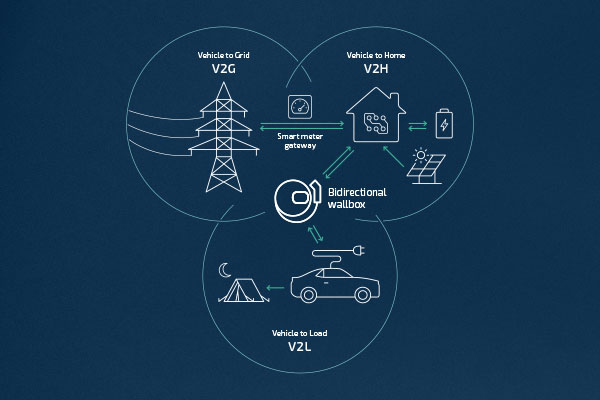Bidirectional wallbox
Bidirectional wallbox

Bidirectional charging is a term that is currently frequently found in the field of electromobility. Bidirectional charging includes the areas Vehicle to Grid (V2G), Vehicle to Home (V2H) and Vehicle to Load (V2L). Each of these use cases has its own specific requirements. Technology-wise, the ghostONE platform is already prepared for some of these use cases.
Vehicle to Grid
Vehicle to Grid looks set to become the most relevant option in terms of the current energy transition. Electric vehicles have a large battery capacity and are expected to have a supporting effect on the power grid through their function as very quickly controllable electricity storage systems. Suitable cars are as yet unavailable; individual car manufacturers are currently developing vehicles with a power feed function. The technical standard for this is known as ISO 15118-20 and is already being developed as a software update for the ghostONE platform. The framework conditions for the other end, the grid, naturally also need to be defined. The prerequisites for this are currently being developed in the context of Section 14a EnWG (German Energy Industry Act). This will specify how a communication channel can be set up via smart meter gateway. Only this infrastructure will make a controllable, grid-friendly feature possible, i.e. grid-supportive bidirectional charging.
Vehicle to Home
Vehicle to Home is also relevant for the ghostONE platform. We have broken this down into two use cases:
Use case 1: Optimising self-consumption and dynamic electricity tariffs
We have been able to charge our electric vehicle with electricity at low cost, either with a dynamic electricity tariff or with our own PV system, and now we want to use this cheap electricity for our home at a later time. This is technically already possible today through the ghostONE platform, but legal regulations to prevent misuse are not yet in place. Misuse could occur, for example, if an e-vehicle is charged at work at no cost (tax-free) and this electricity is then profitably fed back into the grid at home, or not used as traction current.
Use case 2: Emergency power supply
We have a power cut and want to supply the house with “emergency power” using our car’s electricity storage system. This requires a mains disconnection device at the home connection point to prevent the emergency power supply from feeding back into the external power grid, in case repair work is carried out on the power lines. The technical modifications that the wallbox requires to provide a “black start” function will become available in a future generation of the ghostONE platform.
Technology-wise, the ghostONE platform is already prepared for some of these use cases.
Vehicle to Load
Vehicle to Load isn’t relevant for the ghostONE platform but is a real plus for campers and festival goers. In this case, the car has a special adapter that makes it possible to operate a camping cooker or music system using the car’s electricity storage system. Don’t worry, you will still be able to get home again as this only requires a minimal amount of electricity from the car.
WE’RE HERE TO HELP